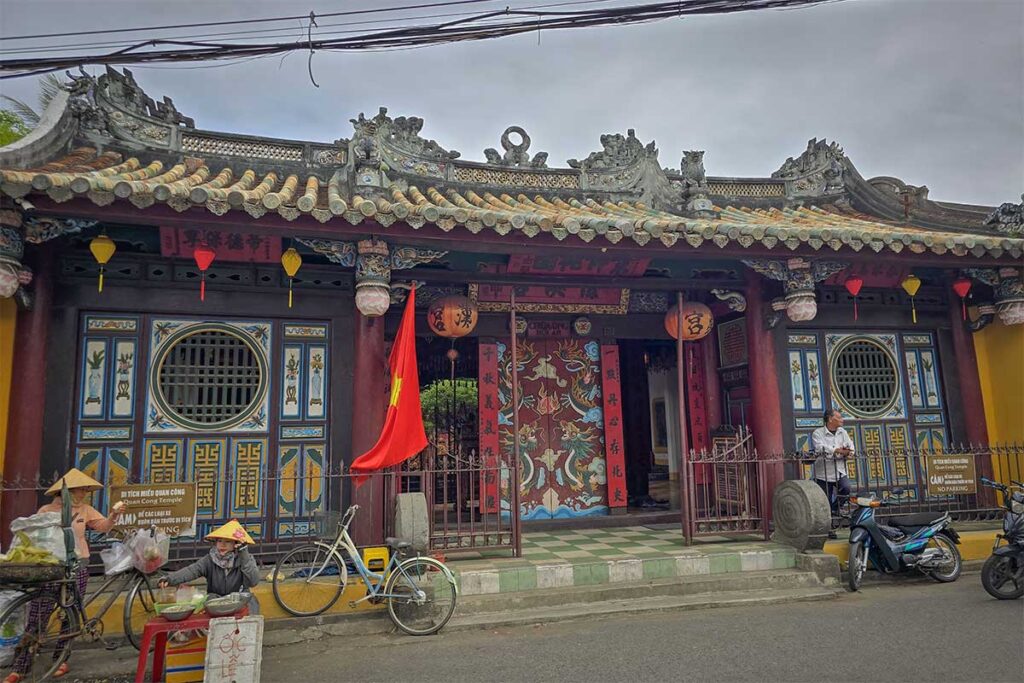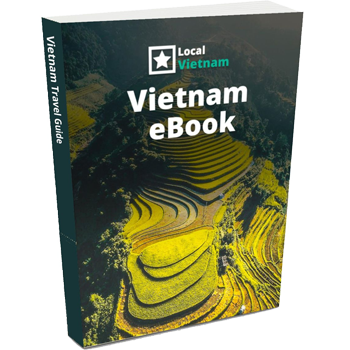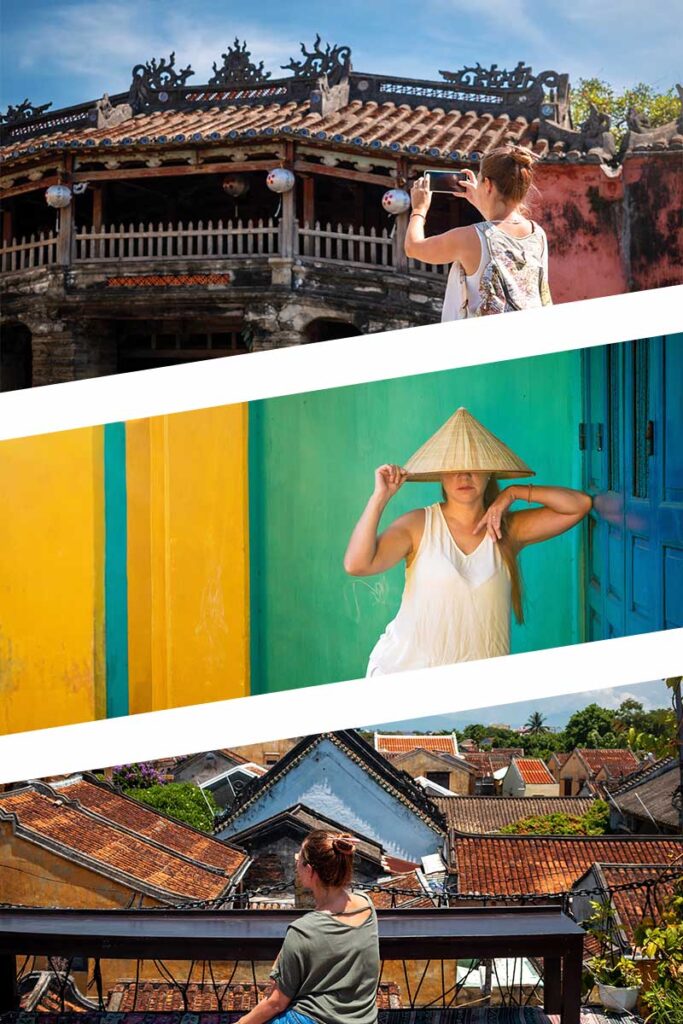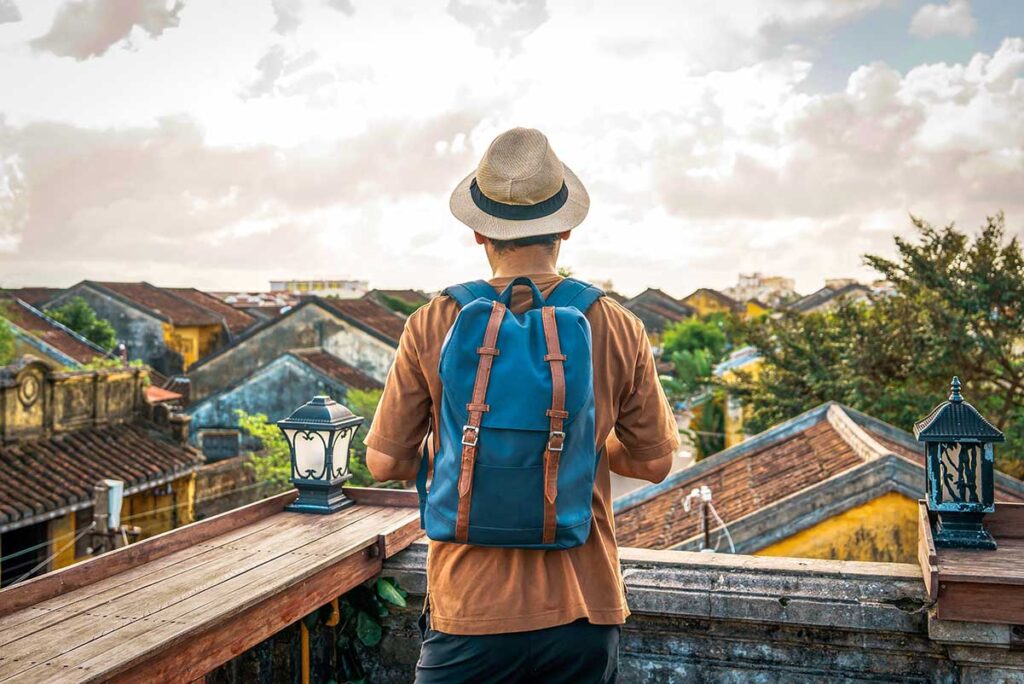What is Quan Cong Temple like?
Quan Cong Temple sits on Tran Phu Street, right in the heart of Hoi An Ancient Town — just a short walk from the Central Market and other historic landmarks. It was originally built in 1653 by Hoi An’s Chinese community, who dedicated the temple to General Quan Cong, a symbol of loyalty and righteousness in Chinese folklore.

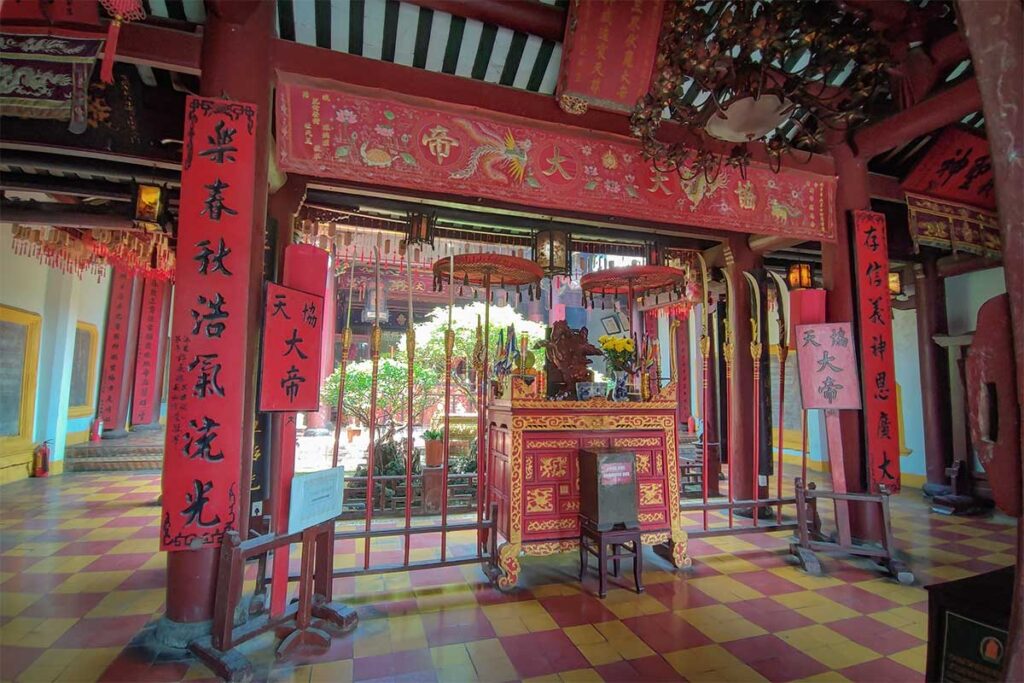
From the outside, the temple is modest in size but eye-catching, with bright red walls, curved tiled roofs, and statues of guardian animals like dragons and tigers. Inside, the atmosphere is peaceful and slightly solemn, with the faint scent of incense lingering in the air. Today, Quan Cong Temple remains a partly active place of worship for locals, while also offering a quiet cultural stop for tourists exploring the Ancient Town.
Hoi An Walking Tour by Local Guide
- Experience Explore Hoi An’s Ancient Town with an expert local guide and insider stories.
- Includes Market visit, traditional house, colorful temples, and coffee break by electric car.
History of Quan Cong Temple
Quan Cong, also known as Guan Yu or Kwan Kung, was a real historical figure from China’s Three Kingdoms period. He was a respected general known for his loyalty, courage, and strong moral code — values that later elevated him to near-mythical status across East Asia. Over time, Quan Cong became worshipped as a deity, especially among merchant communities who saw him as a guardian of trust, justice, and good fortune.
The temple in Hoi An was built in 1653 by Chinese immigrants, most likely from the Cantonese merchant community. At the time, Hoi An was a thriving international trading port, and Chinese settlers brought not only their goods but also their spiritual traditions. They constructed this temple to honor Quan Cong as a protective figure for both personal life and business dealings.
Importantly, the temple also served a practical role in ancient trade. Merchants would come here to make offerings before voyages or even sign contracts, believing the spirit of Quan Cong would enforce honesty and fairness. This connection between commerce and faith made the temple a respected symbol of integrity in Hoi An’s port history.
Restorations and the temple today
Throughout the centuries, Quan Cong Temple has undergone several restorations, especially during the 20th century, but its original structure and symbolism have been carefully preserved. It is now recognized as a National Historic and Cultural Heritage Site in Vietnam.
The temple is also linked to Hoi An’s broader network of Chinese assembly halls, which were both religious and communal spaces for different Chinese ethnic groups. Like the nearby Phuc Kien (Fujian) and Trieu Chau halls, Quan Cong Temple played a role in preserving cultural identity and offering a place for gatherings, rituals, and decision-making.
Highlights & Architecture
Quan Cong Temple is full of symbolic details and carefully preserved craftsmanship that reflect its spiritual meaning and Chinese heritage. Here are the main features to look out for when you visit:
1. Statue of Quan Cong
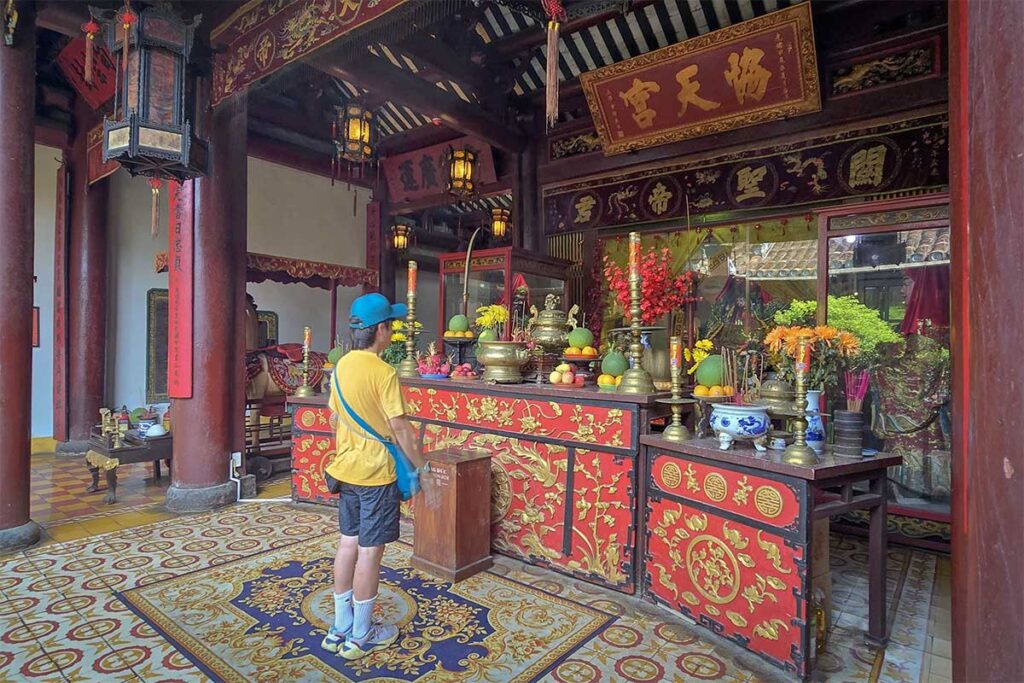
At the heart of the temple stands a striking statue of Quan Cong, painted in bold red and gold. These colors symbolize loyalty, bravery, and righteousness — the core values he represents. He’s shown wearing a dragon-embroidered robe, with a fierce expression and forward-facing eyes that seem to watch over the space. The altar in front of the statue often has offerings of fruit, incense, and paper money, left by both locals and tourists seeking protection, luck, or honesty in business.
2. Guardian Statues (Chau Thuong & Quan Binh)

Flanking Quan Cong are statues of his two loyal companions: Chau Thuong, a fierce warrior, and Quan Binh, his adopted son and administrative aide. These figures represent devotion, strength, and trustworthiness. Outside the temple, you’ll also see guardian animals — typically a tiger and a dragon — which are common in Chinese architecture. They’re placed to ward off evil and bring balance between power and wisdom.
3. Roof & Architectural details
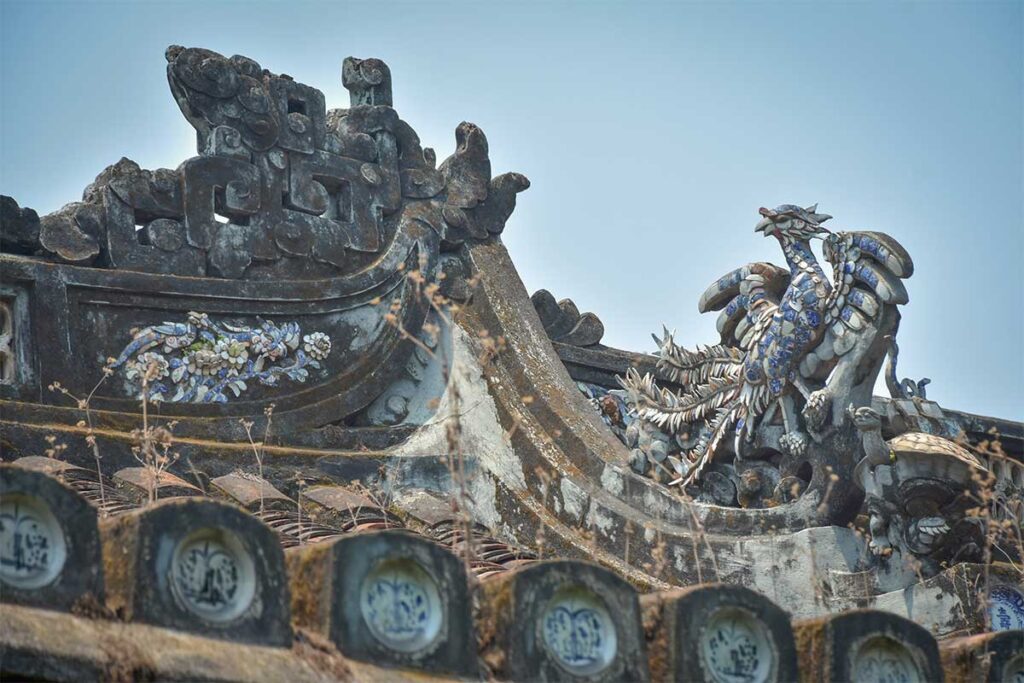
The temple’s architecture is a mix of classical Chinese design with local Vietnamese influences. The roof is covered with green-glazed curved tiles, and its edges are decorated with detailed carvings of dragons, unicorns, and cloud motifs made from colorful porcelain shards. The building layout follows a traditional Chinese courtyard style, meant to bring harmony and good energy.
4. Incense coils & Worship space
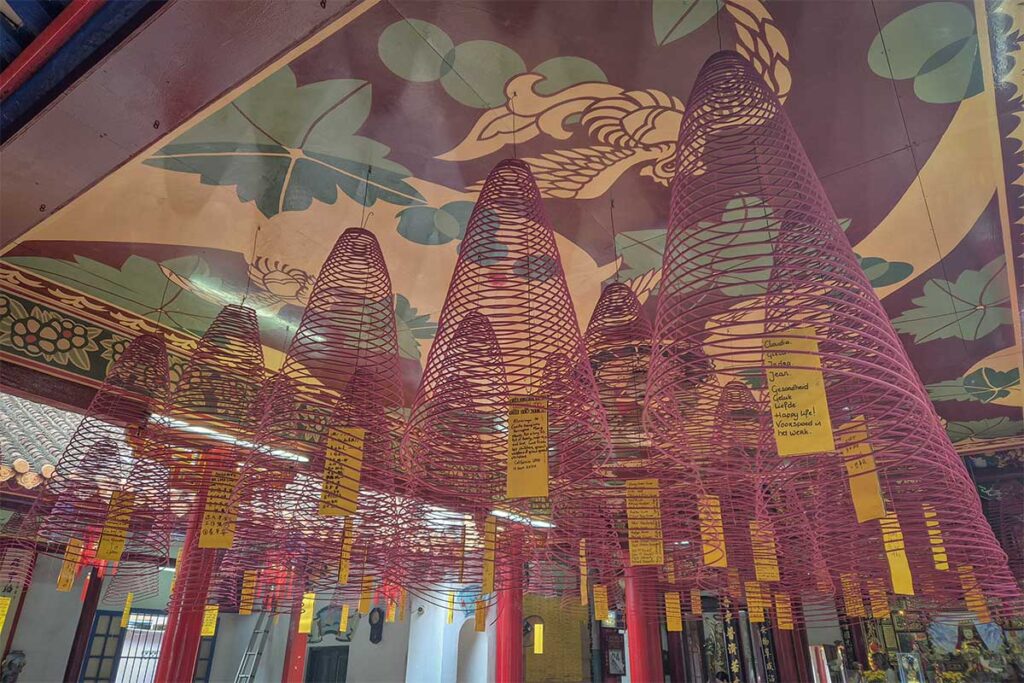
Inside the temple, large spiral incense coils hang from the ceiling, slowly burning throughout the day. Visitors often write wishes on red paper, attach them to the coils, and light them as part of a prayer ritual. The air is filled with a light haze and scent of incense, adding to the tranquil atmosphere. Quan Cong Temple is still active as a place of worship, so you may see locals quietly praying, lighting incense, or leaving offerings.
5. Other notable artifacts

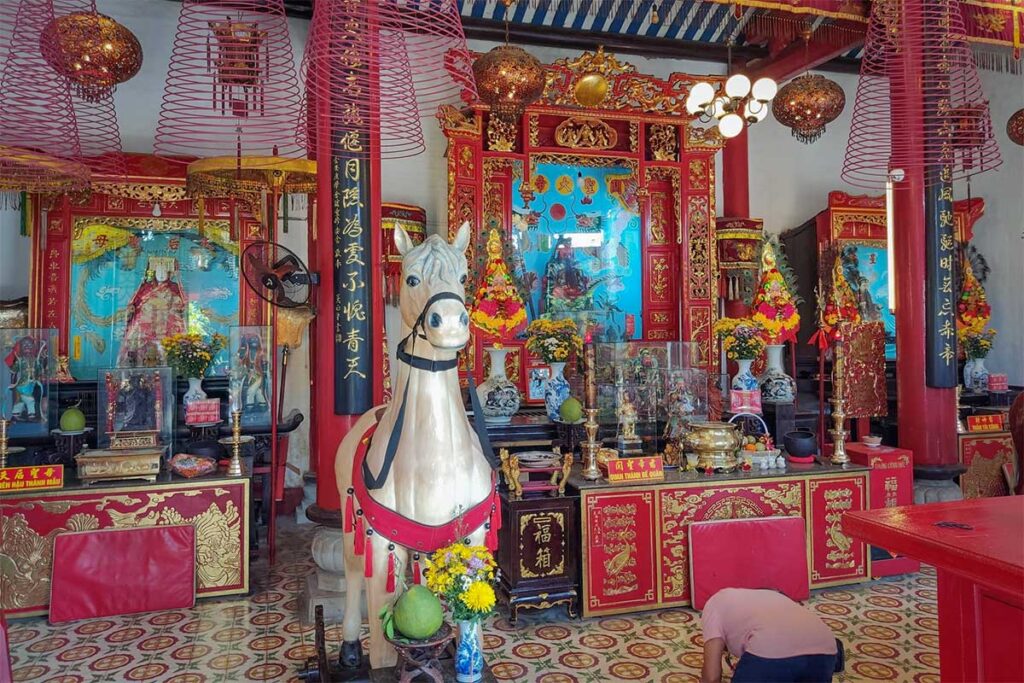
Beyond the main altar, you’ll find two large horse statues — a white horse and a red horse — believed to represent the steeds that carried Quan Cong into battle. There are also antique lacquered boards with Chinese calligraphy, poems, and historic inscriptions, including a rare piece attributed to Nguyen Nghiem, the father of Vietnam’s famous poet Nguyen Du. These artifacts reflect the temple’s long-standing role as both a spiritual site and a cultural archive.
Visiting information
Location
Quan Cong Temple is located at 24 Tran Phu Street, right in the center of Hoi An Ancient Town. It’s just steps away from the Central Market, and close to other popular sites like the Fujian Assembly Hall and the Museum of Folk Culture. You’ll likely pass by it while exploring the main streets of the Old Town
Getting there
If you’re staying inside or near the Ancient Town, the temple is easily reached on foot. For those coming from the beach area or the countryside (like An Bang, Cam Thanh, or Tra Que), the best option is to take a bicycle, taxi, or private car to the edge of the Ancient Town. From there, you’ll need to walk into the pedestrian zone, as motorized vehicles aren’t allowed inside during most hours of the day.
Opening times
Quan Cong Temple is typically open daily from around 7:00 AM to 5:00 PM.
The best time to visit is in the early morning, when it’s quieter and cooler. Midday can get busy, especially with group tours, so try to arrive before 10:00 AM or later in the afternoon for a more peaceful experience.
Entry ticket
The temple itself does not have a separate entrance fee, but it’s located inside the Hoi An Ancient Town, which requires a general entrance ticket. The ticket costs 120,000 VND and includes access to five heritage sites of your choice within the Old Town. Quan Cong Temple is one of the included sites.
Note: You don’t need a ticket for Hoi An Ancient Town itself, only to get into certain museums and historical buildings. Read more about Hoi An Ancient Town, including how the ticket works and all the sights you can visit.
Dress code
As with all temples and places of worship in Vietnam, it’s best to dress modestly. Cover your shoulders and knees, and avoid wearing beachwear or revealing clothing. While shoes are typically allowed in the temple, it’s good practice to act respectfully, speak quietly, and avoid any behavior that could disrupt local worshippers.
Temple Festivals & Traditions
Quan Cong Temple isn’t just a historical site — it’s still an active place of worship, especially during key times of the year tied to local customs and Chinese-Vietnamese traditions.
During Tet (Lunar New Year), the temple becomes a popular spot for locals to pray for luck, health, and success in the coming year. Visitors often write their wishes on red paper and hang them on large spiral incense coils that burn slowly over the altar, sending prayers to the heavens.
Another important occasion is Quan Cong’s birthday, celebrated on the 16th day of the first lunar month. This event draws worshippers from Hoi An and surrounding areas who come to make offerings, light incense, and take part in quiet rituals. It’s not a large festival by tourist standards, but it’s meaningful to the local community — especially merchants, who still see Quan Cong as a protector of honesty in trade.
If you visit the temple around these dates, you might see a more festive and active atmosphere, with extra decorations, prayer rituals, and a steady stream of people writing wishes or leaving offerings. It’s a good moment to witness the temple’s role in Hoi An’s living culture, not just its past.
Tips for visiting
- Come early in the day for the quietest experience. The temple is most peaceful before 9:30 AM, when group tours are less common and the light is great for photos.
- Pair your visit with nearby attractions. Quan Cong Temple is just around the corner from the Central Market, and within walking distance of several Chinese assembly halls, making it easy to include as part of a short walking route through the Ancient Town.
- Stay quiet and respectful, especially if you see locals praying or burning incense. This is still a spiritual place for many residents.
- Bring small change if you’d like to light incense or leave a donation. There’s no pressure to participate, but it’s a simple way to show respect if you feel comfortable doing so.
Is Quan Cong Temple worth visiting?
Quan Cong Temple is small but culturally meaningful — a good stop if you’re interested in Chinese symbolism, historical architecture, or spiritual sites. The setting is peaceful, the details are rich, and the temple offers a quiet break from the busier streets of the Ancient Town.
That said, it’s not a must-see if you’re only after large or visually dramatic sights. With the Hoi An Ancient Town ticket only allowing five included stops, you’ll need to decide whether this temple fits your interests more than, say, a larger assembly hall or one of the main museums.
